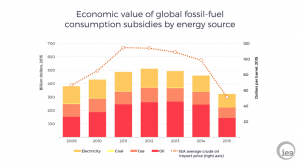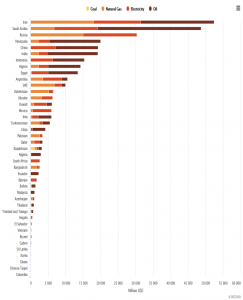The International Energy Agency (IEA) estimates global fossil fuel consumption subsidies that measure what many developing countries spend to provide below-market cost fuel to their citizens. In 2015, IEA estimated that global fossil fuel consumption subsidies—used by many developing countries to provide below-market cost fuel to their citizens—totaled $320 billion, 35 percent lower ($173 billion less) than in 2014.[i] Among the factors in the decrease are lower international energy prices—particularly oil prices—and pricing reform. Oil subsidies accounted for 44 percent of total consumption subsidies (about $145 billion), followed by electricity subsidies of just over $100 billion. Natural gas consumption subsidies amounted to about $75 billion and coal subsidies to $1 billion. The United States does not have any consumption subsidies for oil, coal, electricity or natural gas.
The figure below shows the change in global fossil fuel subsidies between 2009 and 2015. Subsidies peaked in 2012 and there was a substantial reduction in 2015. The estimated subsidies have fluctuated considerably since 2008, primarily because of changes to oil prices.[ii]
Global Fossil Fuel Consumption Subsidies, 2009-2015
Source: https://www.iea.org/newsroom/news/2017/april/commentary-putting-the-right-price-on-energy.html
The IEA is a part of the Organization for Economic Cooperation and Development (OECD), which represents the developed nations of the world. IEA found that many developing countries artificially lower energy prices to their citizens, paying the difference from their government resources.[iii] These wealth transfers are differentiable from subsidies that are intended to support uneconomic energy sources such as wind and solar technologies toward commercialization. In contrast, the United States and other developed countries offer support to energy production in the form of tax credits, loan guarantees or use mandates, which are not included in IEA’s fossil fuel consumption subsidy calculations since they are directed towards production rather than consumption of the fuel.
According to the IEA, global fossil fuel consumption subsidies are over twice as large as subsidies for renewable energy in 2015, which amounted to $150 billion globally—$120 billion for non-hydro renewables for power generation and about $30 billion for renewables in other sectors, primarily biofuels. In contrast to fossil fuel consumption subsidies, renewable fuel subsidies often take the form of tax credits for investment or production, or premiums over market prices to cover the higher production costs compared to traditional fuels.
Fossil Fuel Consumption Subsidies by Country
There are some 40 countries responsible for most of the subsidies given to fossil-fuel companies. Many of the countries providing fossil fuel consumption subsidies own state energy companies, including countries that comprise the Organization of Petroleum Exporting Countries, such as Iran, Saudi Arabia, and Venezuela. The other big contributors are large developing economies like India, China, and Indonesia, which see the subsidies as a means of making life easier for their poorest citizens. Fossil fuel consumption subsidies are often used to alleviate energy poverty, but are an inefficient means for doing so, creating market distortions that result in wasteful energy consumption. Developed countries, such as the United States, do not have fossil fuel consumption subsidies, as seen in the chart below.
Iran leads the world in fossil fuel consumption subsidies providing $52.4 billion from its government resources in 2015 to lower the cost of fossil fuels to end-users in its country. Of the $52.4 billion in fossil fuel consumption subsidies Iran paid, 40 percent covered oil, 34 percent funded natural gas, and the remainder (26 percent) went to electricity. Saudi Arabia is the second-leading subsidizer of end-use fossil fuel prices, providing 61 percent of its $48.6 billion in fossil fuel consumption subsidies to oil, 26 percent to electricity, and 14 percent to natural gas in 2015. Russia ranked third with $30.3 billion in fossil fuel consumption subsidies, 49 percent covering natural gas and 51 percent going to electricity. Venezuela ranked fourth with fossil fuel consumption subsidies totaling $19.9 billion, 73 percent covering oil, 11 percent covering natural gas and 16 percent covering electricity. China came in fifth with fossil fuel consumption subsidies totaling $19.24 billion, 63 percent covering oil and 37 percent covering electricity. India was sixth with $19.21 billion in fossil fuel consumption subsidies—oil garnered 75 percent, electricity 13 percent, and natural gas 12 percent.
Coal received $1 billion in fossil fuel consumption subsidies, just 0.3 percent of the total. Kazakhstan was the only country that subsidized coal in 2015.
Some countries have instituted pricing reform, particularly for oil products in the transportation sector. Both Malaysia and Indonesia have recently removed gasoline subsidies, and Mexico is on the verge of completely liberalizing gasoline prices. The value of oil product subsidies in APEC (Asia-Pacific Economic Cooperation) countries fell by over 50 percent since 2010, with most of the decline due to pricing reforms rather than changes in international prices. The IEA found that about 60 percent of fossil fuel subsidies in the APEC economies is now in the residential sector, for electricity, gas and LPG. Subsidized electricity prices in some economies are a reason for the poor financial state of utilities, undermining their ability to invest in new energy infrastructure.
Global Fossil Fuel Consumption Subsidies by Country, 2015 (Million Dollars)
Source: IEA, http://www.iea.org/statistics/resources/energysubsidies/
The Push to End Fossil Fuel Subsidies
At the G20 summit in Hangzhou on September 4 and 5, 2016, the United States pressed the leaders of major global economies to outline specific plans to phase out most fossil fuel subsidies. Prior to that meeting, the energy ministers from the G20 countries met, but did not reach an agreement on a timeline for the subsidy phase-out. But, the G7 nations met in May 2016, agreeing to end most “inefficient” fossil fuel subsidies by 2025.[iv]
Saudi Arabia, Russia and China oppose the elimination of fossil fuel subsidies. The royal Saudi government is inextricably linked with state-owned Saudi Aramco, the world’s largest energy company. Despite that, Saudi Arabia scaled back some fossil fuel consumption subsidies that artificially lowered the price of fuel for its citizens, increasing its country’s gasoline prices by 50 percent. Bahrain raised gas prices for its residents by 56 percent and Qatar by 30 percent, although their subsidized rates are still well below market levels. Oil consumption in the Middle East has grown nearly 4 times faster than the global average, partly because subsidized gasoline is so inexpensive. Russia, one of the world’s largest oil producers, is dependent on oil and gas industry revenue for half of its federal budget, and is unlikely to eliminate its fossil fuel subsidies.[v]
Conclusion
Many Americans are confused by the large amount of global fossil fuel consumption subsidies that the IEA calculates, not realizing that these subsidies have nothing to do with tax policy, research and development or loan guarantees, where most U.S. programs are directed. In fact, most liberalized countries do not offer fossil fuel consumption subsidies that artificially lower the end-use price of the fuel. Fossil fuel consumption subsidies are common and even pervasive in the developing world, particularly in economies with state-owned energy companies. The IEA has been advocating for years that fossil fuel consumption subsidies should be eliminated since they encourage wasteful consumption.
Fossil fuel consumption subsidies in developing countries are welfare transfers that can be differentiated from subsidies in the name of commercializing or sustaining uneconomic energy sources such as on-grid wind or solar, which the United States and other industrialized countries have been subsidizing. These latter forms of energy subsidies that help promote production of uneconomic energy sources can be abolished without detrimental effects to the U.S. economy or its citizens. In fact, they would increase economic efficiency since by their very nature, they are generally more expensive than competing forms of energy.
The OECD countries find fault with developing countries for subsidizing the costs of energy purchased by their citizens, but those same OECD nations are busy subsidizing and mandating the use of uneconomic and inefficient forms of energy which will make energy more expensive and less reliable for their citizens. The economies would be better off if all such supports by governments were abolished.
[i] International Energy Agency, Energy Subsidies, http://www.iea.org/statistics/resources/energysubsidies/
[ii] International Energy Agency, Commentary: Putting the right price on energy, April 27, 2017, https://www.iea.org/newsroom/news/2017/april/commentary-putting-the-right-price-on-energy.html
[iii] International Energy Agency, Fossil Fuel Subsidies—Methodology and Assumptions, http://www.worldenergyoutlook.org/resources/energysubsidies/methodology/
[iv] Reuters, Pressure for G20 deadline on fossil fuel subsidies shifts to Germany, September 6, 2016, http://www.reuters.com/article/us-g20-climatechange-fossilfuels-subsidi-idUSKCN11C259 and Argus, Obama to push G20 to cut fossil fuel subsidies, August 31, 2016, http://www.argusmedia.com/news/article/?id=1303970
[v] Washington Diplomat, The Burning Debate over Fossil Fuel Subsidies, September 1, 2016, http://www.washdiplomat.com/index.php?option=com_content&view=article&id=14052:the-burning-debate-over-fossil-fuel-subsidies&catid=1548&Itemid=428





